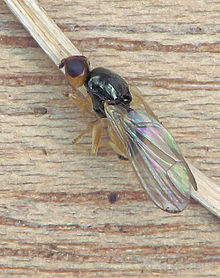- Carrot fly
-
Carrot fly 
Scientific classification Kingdom: Animalia Phylum: Arthropoda Class: Insecta Order: Diptera Section: Schizophora Family: Psilidae Subfamily: Psilinae Genus: Chamaepsila Subgenus: Chamaepsila Species: C. rosae Binomial name Chamaepsila (Chamaepsila) rosae
(Fabricius, 1794)Synonyms The carrot fly (Chamaepsila rosae) is a pest of gardens and farms, and mainly affects the crop of carrots, but can also attack parsnips, parsley and celery.It is a member of the family Psilidae (order Diptera).
Contents
Larvae
It is the larvae of the carrot fly that harms crops. The creamy-yellow maggots feed on the outer layers of the carrot root. In autumn they may penetrate further into the root. The larvae are legless and up to 10 mm in length.
Symptoms of infestation
Foliage becomes wilted and discoloured. Leaves turn rusty red to scarlet with some yellowing. Rusty-brown tunnels are seen under the outer skin of mature roots.
Control
The flies lay their eggs around the developing carrots; the larvae, once hatched, burrow into the root. As female carrot flies are very low flying, the best method of prevention is to erect a barrier around the crop at least 60 cm high. Alternatively horticultural fleece may be used as a floating mulch to cover the crop. Some plants such as Rosemary, Sage, and Marigold are used to deter the carrot fly. Newer varieties of carrot which claim to be resistant to carrot fly (e.g. "Flyaway") may be used.
Latin Name
The original species name of Musca rosae (Fabricius in Entomologia systematica emendata et aucta (1794)) was itself preoccupied by Musca rosae (De Geer 1776), which was itself a synonym of the hoverfly species Musca pyrastri Linnaeus, 1758 (now Scaeva pyrastri). The new name of Chamaepsila hennigi was proposed for the Carrot fly by Thompson & Pont in 1994. As the name rosae Fabricius was well known for this major crop pest, applications were made to the International Commission on Zoological Nomenclature for suppression of the name rosae of De Geer and the conservation of rosae of Fabricius. In 2006 they ruled under their plenary powers that rosae Fabricius, 1794 was not to be regarded as invalid by reason of being a junior primary homonym of Musca rosae De Geer, 1776.
External links
References
- Christopher Brickell (2002). The Royal Horticultural Society Encyclopedia of Gardening. Dorling Kindersley. ISBN 0-7513-0862-5.

This article related to members of the insect order Diptera (true flies) is a stub. You can help Wikipedia by expanding it.
